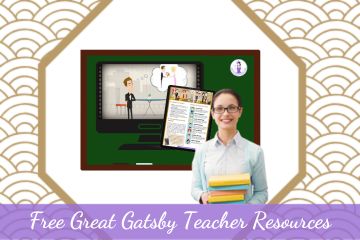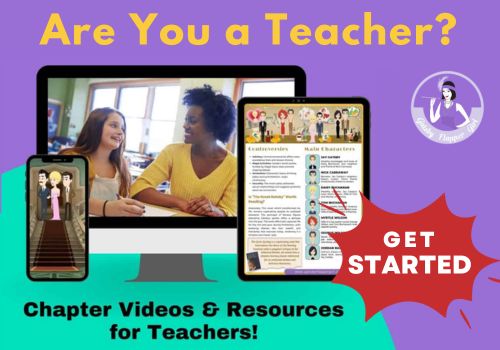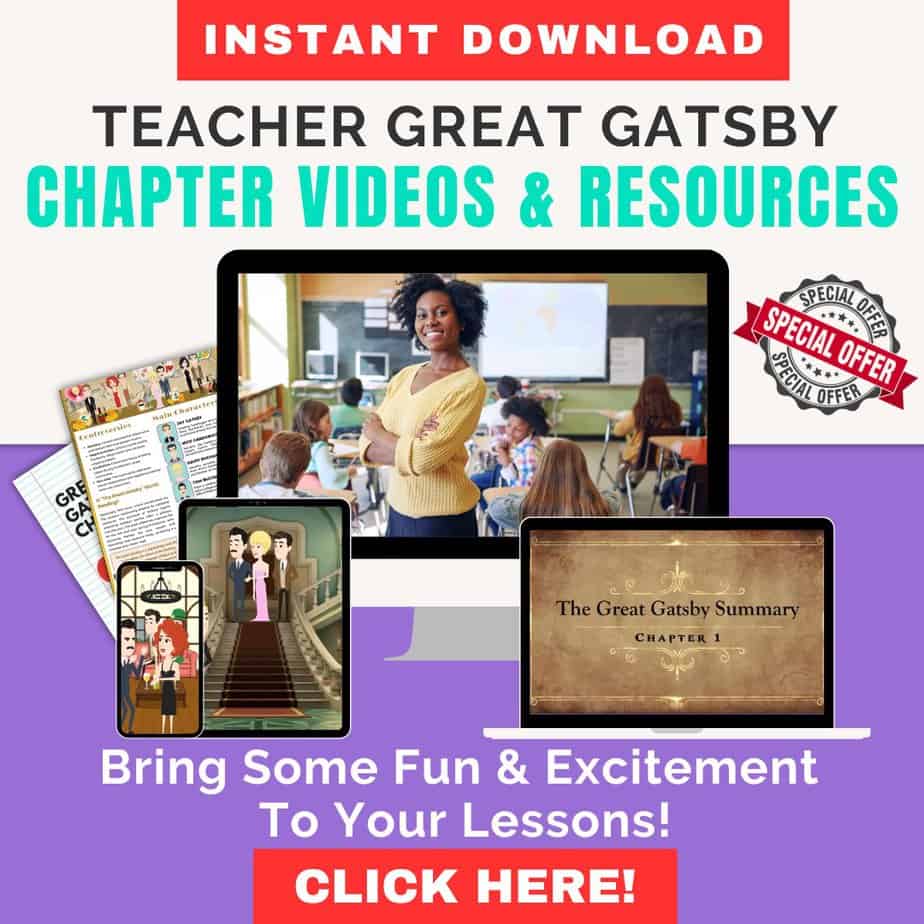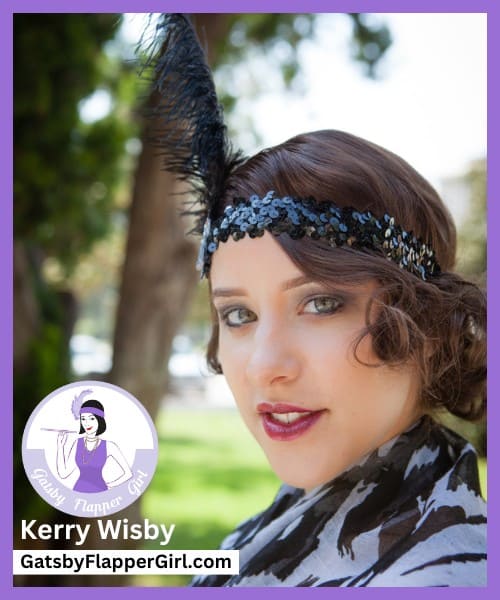Whether you’re a homeschooler, a teacher who has decided to add The Great Gatsby to your curriculum, or you’ve been assigned to teach this novel per the school board, you’re in luck!
As a former teacher with a passion for bringing literature to life in the classroom, I’m thrilled to share a treasure trove of free Great Gatsby teaching resources with you.
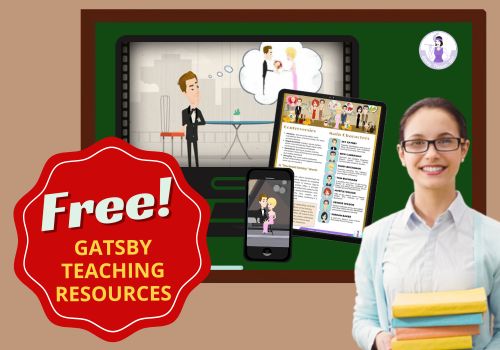
F. Scott Fitzgerald’s masterpiece, The Great Gatsby, has stood the test of time as a quintessential American novel, exploring themes of excess, disillusionment, and the American Dream during the Roaring Twenties.
Whether you’re a seasoned teacher looking to revamp your curriculum or a fresh-faced educator embarking on your first Gatsby journey, you’ll find these resources helpful in enhancing your student’s understanding of this iconic work.
In this article, I’ll walk you through an array of tools, from discussion guides and character analyses to interactive multimedia presentations and creative project ideas.
You’ll discover innovative ways to immerse your students in the glitzy world of Jay Gatsby, Daisy Buchanan, and Nick Carraway, and the vivid imagery and metaphors of Scott Fitzgerald.
These resources are not just about dissecting the text but also fostering critical thinking, sparking lively discussions, and igniting a love for literature. Whether you’re exploring themes, symbolism, or character development, you’ll find these materials adaptable for various grade levels and learning styles.
Join me on this journey into the Jazz Age, as we make The Great Gatsby a vivid and unforgettable part of your curriculum.
How Do I Start Teaching The Great Gatsby?
I can guarantee that if you plop the book on your students desk and tell them to read the first three chapters, you’ll get lots of rolling eyes and lose their interest. Unless your students are hard core literature fanatics, they will read about three pages (not chapters but pages) and give up.
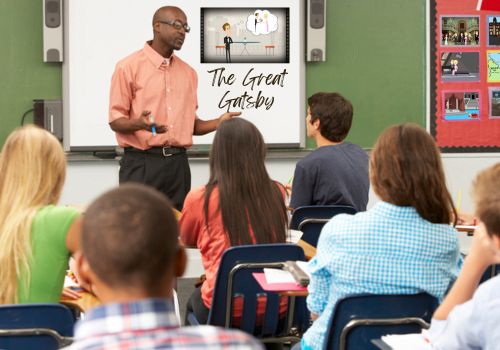
Let’s face it, all that flowery imagery that Scott Fitzgerald uses are not the literary genre that students read today.
Before I would even mention Fitzgerald’s novel, I would start off with some pre-reading comprehension exercises.
Get Them Into What the 1920s Was All About
Your students may or may not be history buffs, but I bet you can interest them by talking about things such as Prohibition – how it spawned illegal activity and how that illegal activity was a breeding ground for gangs and violence.
You might want to suggest they watch The Untouchables (with Kevin Costner) as a way of seeing how Prohibition worked. (Some parents might object to the violence in the movie, so gauge your community carefully.)
Once my students were well versed in Prohibition and gangs, I had them suggest other unpopular laws and how they also bred violence and gangs.

Most of my students were not into jazz music, but I made sure to talk about how jazz (and music in general) literally changed the face of America. Compare jazz to hip-hop or rap to help students strengthen their grasp of the changes that were taking place during the period.
I also would create a timeline that included changes in the country from about 1880 to 1920. This included fashion, WWI, music, dancing, and social norms.
Once I felt that my class was familiar with how and why the 1920s were so dramatic and so important, I introduced The Great Gatsby.
How to Interest Students in the Novel
Chances are that your students will find Chapter 1 a bit of a bore. I would always encourage them to keep reading because this chapter would reveal some juicy secrets and the “perfect” couple Tom and Daisy Buchanan.

Some ideas that I had success with include:
1. Gatsby’s Mansion VR Tour: Transport your students to the opulent world of Jay Gatsby’s mansion with a virtual reality (VR) tour. Use VR headsets or even smartphone apps to allow students to explore key locations described in the novel, such as the grand ballroom, Gatsby’s library, or his meticulously maintained garden. This immersive experience can make the setting and era come to life, creating a deeper connection to the story.
2. Character Instagram Profiles: Have your students create modern-day Instagram profiles for the novel’s characters. They can choose images, captions, and hashtags that reflect each character’s personality and role in the story. This creative activity not only helps students understand the characters better but also encourages them to think critically about how these characters would present themselves and their point of view in the digital age. If phones are not allowed in your school, place students in groups and assign a character to each group. Have them create posters that simulate Instagram or Facebook.
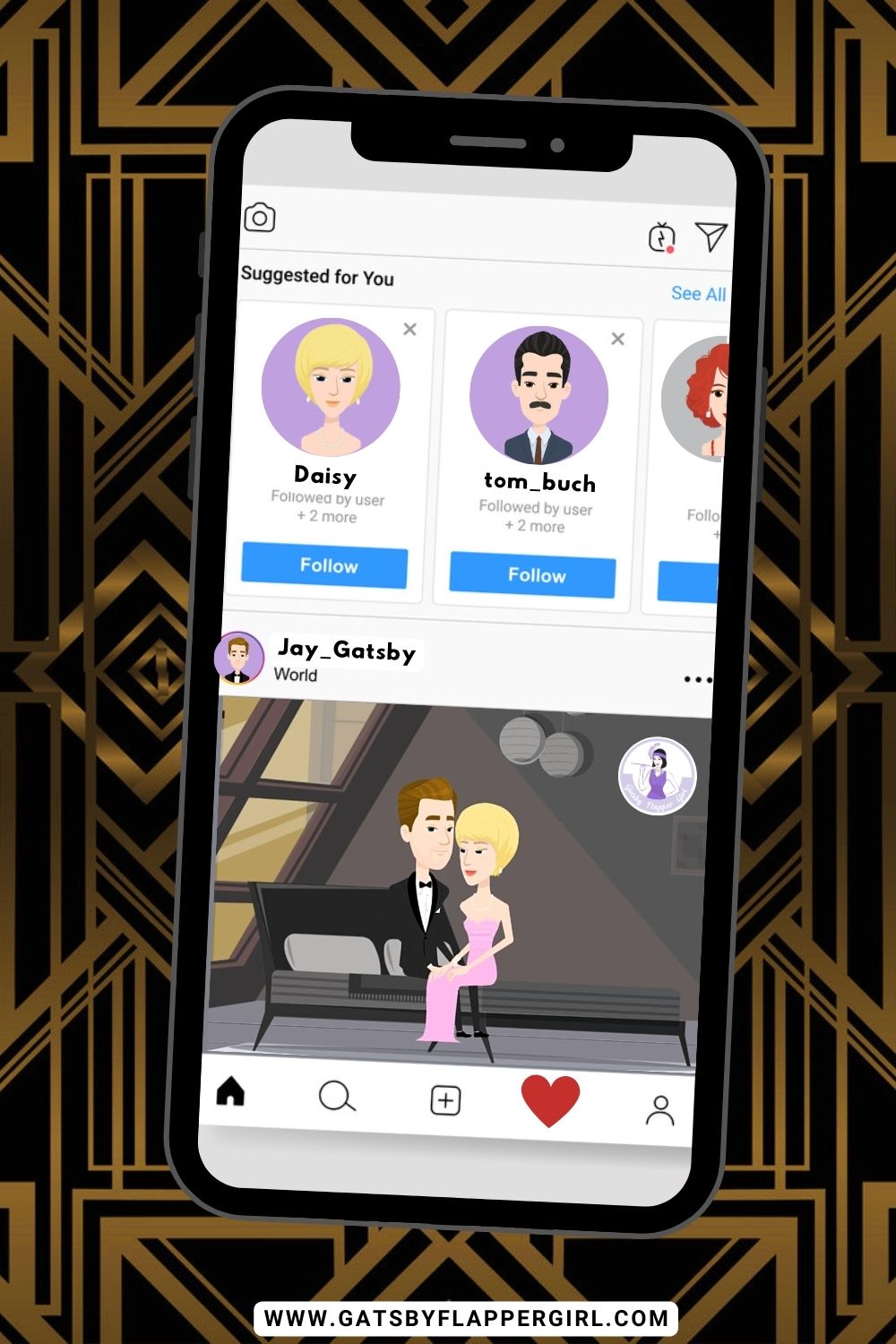
3. Jazz Age Music Playlists: Build a playlist of Jazz Age music that captures the spirit of the era, featuring songs by artists like Louis Armstrong, Duke Ellington, and Josephine Baker. Discuss how these songs relate to scenes or characters in the novel, and even have students create their own playlists to enhance their understanding of the time period.
4. Gatsby-Themed Art Gallery: Encourage students to create visual art inspired by the novel. Ask them to produce paintings, drawings, or digital art that depicts scenes (Gatsby’s mansion and garden, Tom’s apartment in New York, Wilson’s garage, etc.), characters, or themes from The Great Gatsby. Transform your classroom into a Gatsby-themed art gallery where students can showcase their work and explain their artistic choices in relation to the text.

5. Letters from Gatsby: Challenge students to write letters from the perspective of Jay Gatsby to various characters in the novel or letters that Gatsby may have written Daisy and vice versa. These letters can provide insights into Gatsby’s thoughts and emotions, exploring what he might have written had he been able to communicate more openly. This creative writing exercise helps students delve deeper into Gatsby’s character, point of view, and motivations.
These innovative approaches can make The Great Gatsby more engaging and relevant to your students, fostering a deeper appreciation for the novel and its themes.
Let Movies and Videos Do Their Part
Your students grew up with television, movies, HBO, Netflix, and YouTube. It only makes sense that you should try incorporating some of these into lesson plans to help make things easier for your students to understand.

Yes, some students are going to try to watch either (or both) the 2013 movie with Leonardo DiCaprio and the 1974 movie with Robert Redford. You can remind your students that while the movies will tell them the plot, both movies are different from the novel.
I often used these movies as another means of engaging students and encouraging them to read.
After assigning them to read Chapter 1, I would play the first “chapter” of the 2013 movie, then ask students what was different about the movie from the novel. I often discovered right there who read the first chapter and who didn’t!
You can also simply skip and play different scenes featuring one character and talk about what the character meant when they said a line or a quote. You can also ask if your students thought this character was being truthful, then let them defend their answer.
Let’s say your class is full of students who are more talkative and restless than usual (I once had a class of drama students!) You can always have them create short plays about one chapter or one event in the novel.
Nothing brings home the story better like seeing your friend (playing Daisy) getting cheated on by her husband, while another friend (playing Nick) simply watches and says nothing.
Let’s face it, everyone loves easy-to-understand videos and movies, which is why I’ve created super helpful videos that can help you reach your students as you maneuver through this challenging novel.
Essential Questions for Teaching The Great Gatsby

In my Teaching Guide for Teachers, I’ve got dozens of downloadable PDFs with questions that will challenge students and, hopefully, prevent boredom.
Some questions you might want to discuss with your students include the following:
1. What is the American Dream, and how does it manifest in the novel? This question encourages students to analyze the various characters’ interpretations of the American Dream and its significance within the story. Challenge your students to create a “perfect world” scenario of what they feel the American Dream entails and why.
2. What role does social class play in the lives of the characters, and how does it affect their choices and relationships? By examining the characters’ social backgrounds and behaviors, students can explore the theme of social class and its impact on their actions and desires.
3. Is Gatsby a hero or an anti-hero? Encourage students to debate whether Jay Gatsby is a tragic hero pursuing his dreams or a morally ambiguous figure driven by obsession. Remind students to use valid reasoning and support their arguments with relevant and sufficient evidence.
4. What are the moral and ethical dilemmas faced by the characters, and how do they make choices? This question prompts students to evaluate the characters’ moral compasses and decisions, providing insight into their development and motivations.
5. How does the 1920s setting and culture shape the events and characters in the novel? Explore the socio-historical context of the Jazz Age, including the Prohibition era, extravagant parties, and shifting values, and how these factors influence the narrative. Students can do group work, where they can share ideas and support their claims with examples and textual evidence.
6. What symbolism is present in the story, and how does it contribute to the novel’s meaning? Analyzing symbols such as the green light, the Valley of Ashes, and the eyes of Dr. T.J. Eckleburg deepens students’ understanding of the text’s allegorical elements.
7. What is the role of illusion and reality in the characters’ lives? This question encourages students to examine the characters’ self-constructed facades and the contrast between their idealized perceptions and the harsh realities they face.
8. How does the author’s narrative style and the use of an unreliable narrator (Nick Carraway) influence the reader’s understanding of the story? Explore Fitzgerald’s narrative techniques and the impact of having Nick as the storyteller, considering the biases and limitations inherent in his perspective.
9. What are the consequences of the characters’ pursuit of happiness and their relentless desires? Encourage students to examine the themes of ambition and the pursuit of happiness, analyze the way characters treat one another in pursuit of their aspirations, and how their actions lead to both positive and negative outcomes in the novel.
10. In what ways does The Great Gatsby comment on the decay of the American Dream and the notion of the ‘hollow pursuit of wealth’? Foster a discussion about how the novel critiques the superficiality and moral decay associated with the relentless pursuit of material success, even at the expense of genuine human connections and happiness.
These questions will naturally branch off into other questions and should hopefully make for a lively discussion.
By exploring these themes and character dynamics, students can uncover the timeless relevance of the novel and appreciate its enduring literary significance.
Fun Yet Meaningful Activities for Teaching The Great Gatsby
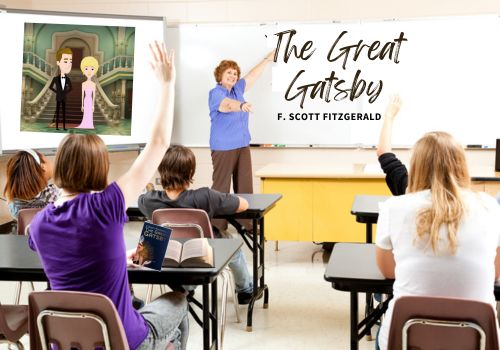
You’ve probably guessed by now that I never wanted to be the teacher with the class that students dreaded.
You know the one- maybe the subject matter was interesting, but the teacher is a stick in the mud. Or the teacher could be creative, but if the subject was a bore, no one wanted to attend class.
We do need to maintain a teaching environment, but that doesn’t mean we can’t have fun while we do so! If you think about Sesame Street or Mr. Rogers, you’ll get the idea.
My favorite teacher was my creative writing teacher in high school. She marched my class out to the football field and had us all enjoy a sunny afternoon and write about being a plant. Any plant. Sitting in the grass, feeling the warmth of the sun was a real inspiration, and I think everyone wrote outstanding poems!
Don’t be afraid to get creative with your teaching methods and Great Gatsby lesson plan! Consider some of the following:
1. Host a Gatsby-themed party or day in the classroom. Encourage students to dress in Roaring Twenties attire, play Jazz Age music, and serve snacks reminiscent of the era. This immersive experience can transport students into the world of Jay Gatsby, making the setting and characters more relatable.

2. Create a Scavenger Hunt. Have students search for modern pop culture references to The Great Gatsby. Explore how elements of the novel appear in contemporary songs, movies, and advertisements. You could also give students a list of items to hunt for, such as pictures of mansions, hair clips that Daisy would wear, and champagne goblets (plastic!), and have them create a diorama or place them on their poster.
3. Get Artsy. Encourage students to get creative by producing their own Gatsby-inspired artwork, poetry, or music. This hands-on approach allows them to express their understanding of the novel’s themes and characters in a personal and imaginative way.
4. Celebrate Fashion. Students can wear a flapper dress (a modest one) or design an outfit for a friend. Have girls wear 1920s headbands (they could make them in class perhaps?), and the boys can wear a tie or a fedora. Who knows, you may start a new trend in school!
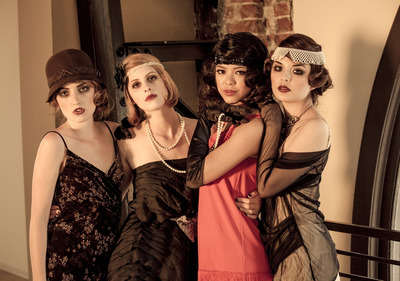
5. Do the Charleston!- If you don’t know already, it’s time to learn the Charleston. Or the Foxtrot. Pick a dance craze (the shimmy is easy), and teach your students how to dance!
By blending enjoyment with depth and creativity, teaching The Great Gatsby becomes a memorable and enriching experience, ensuring that students not only comprehend the text but also appreciate its enduring relevance and artistic value.
Free Resources and More for Teachers
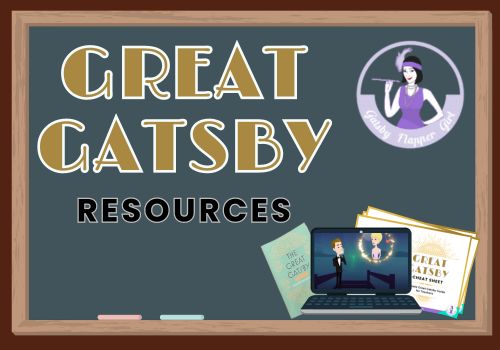
I realize that many teachers are forced to teach more than one subject. This means that time is your most valuable resource and creating lesson plans for The Great Gatsby can be quite time consuming.
That’s why I created an easy-to-use Great Gatsby Teacher’s Guide.
In my journey as an educator, I’ve discovered that teaching The Great Gatsby can be both engaging and insightful by embracing fun, creative, and meaningful approaches. The classroom can become a portal to the Roaring Twenties with Gatsby-themed parties, where students dress the part, dance to jazz tunes, and savor era-inspired snacks, creating a vibrant and immersive learning experience.
Exploring modern pop culture references to Gatsby opens doors to fascinating discussions on how this classic novel still resonates in today’s world. The American Dream, excess, and social class divisions continue to shape our society, and students can readily identify these themes in popular culture.
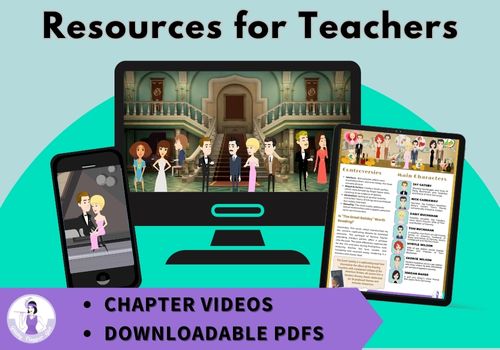
I’m only too happy to share my ideas and activities that have been successful, but I also realize that time is a precious commodity in the life of a teacher.
I’ve tried my best to break down each section of the novel so you can prepare for the section you want to study this semester or enjoy the full series of tests, essential questions, study guides and more all in one place with my complete Teacher’s Guide.
If you’re looking to implement these creative and engaging teaching methods effectively, don’t miss out on my comprehensive teacher resource and video guide.
This guide is a valuable tool that provides step-by-step instructions, resources, and video demonstrations, making your journey in teaching The Great Gatsby both enriching and enjoyable.
Click the link to purchase your guide and transform your classroom into a vibrant hub of learning and discovery.
I’m so excited thinking about how your students will be talking about you and your class as the best class (and teacher) they ever had!
